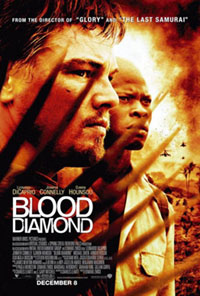 BLOOD DIAMOND
BLOOD DIAMOND(R)
**1/2 (out of 5)
December 8, 2006
STARRING
Leonardo DiCaprio as DANNY ARCHER
Djimon Hounsou as SOLOMON VANDY
Jennifer Connelly as MADDY BOWEN
Kagiso Kuypers as DIA VANDY
Arnold Vosloo as COLONEL COETZEE
Studio: Warner Bros.
Directed by: Edward Zwick
BY KEVIN CARR
Listen to Kevin’s radio review…
Over the past several years, there have been a series of films released that take place in various African countries: “Tears of the Sun,” “The Constant Gardener,” “The Last King of Scotland,” “Catch a Fire.” This trend is topped off with the new film “Blood Diamond.”
If these films have taught me anything, it’s that Africa is possibly the worst place to live in the world. That’s not a slam on Africa in general, but rather on how the continent is portrayed in Hollywood films.
“Blood Diamond” focuses on the diamond trade, specifically the conditions in Sierra Leone about ten years ago. At this time, rebels and warlords slaughtered villagers and enslaved the men to mine diamonds from their land. Then the diamonds are smuggled across the border to disappear into the legitimate marketplace.
Leonardo DiCaprio plays a smuggler named Danny Archer who stumbles across Solomon Vandy (Djimon Hounsou). Vandy was enslaved by a local warlord to mine for diamonds. During his work, he digs up a massive red diamond, which he hides right before the area is stormed by government troops. Archer teams up with Vandy to recover the diamond. Archer wants to use the profits to disappear from his nefarious life, but Vandy wants to use the leverage of the stone to free his son, who has been kidnapped and brainwashed by the rebels.
The intent of the film is to get people to think about where that engagement ring might have come from and who might have died for it. However, the film tries to juggle too many characters and purposes throughout its long running time. With decent acting and action scenes that are violent and numerous (often too violent and numerous), “Blood Diamond” works on many levels, although it doesn’t do so consistently.
One part of the whole diamond industry quagmire that the film only brushes over is the artificiality of their rarity. The reality is that diamonds are rare compared to limestone or granite, but they are not so rare to justify their high prices. Ultimately, the diamond industry holds many of the stones back to control the supply. This is touched on at one point, but really isn’t driven home.
Sadly, the politics of diamonds is something that will never change. It’s not like dolphin-safe tuna, which easily became a rallying point. After all, how hard is it to not eat tuna until they stop slaughtering dolphins? Try refusing to buy your fiancée a diamond ring, and see it’s similarly easy.
The truth is that we’ve seen these arguments made many times before. Heck, I remember a lot of these issues show up in “Diamonds Are Forever,” which came out 35 years ago. As long as they sparkle, diamonds will be coveted – regardless of the atrocities that are committed to get them to market. It’s not that I want this to be true. I wish it weren’t. But this is an industry driven by money, and that’s what ultimately rules.
Another subtle stumbling is the fact that the filmmakers needed to make white people the main characters. Sure, Djimon Hounsou and his character’s family are black, but their story is more a vehicle to drive the plot. The character development and change mostly takes place in DiCaprio’s character.
Not only is the main hero white, but so are the main villains. While there are minor black villains in the films, the real bad guys are played by white men – Arnold Vosloo as a crazy warrior colonel and Michael Sheen as the evil head of the international diamond conglomerate DeBeers… er, I mean Van De Kaap.
Is Hollywood so crippled by simultaneous political and institutionalized racism that they won’t allow black people to be heroes and villains outside of biopics like “Ray” or comedies like “Diary of a Mad Black Woman”?
Podcast: Play in new window | Download
